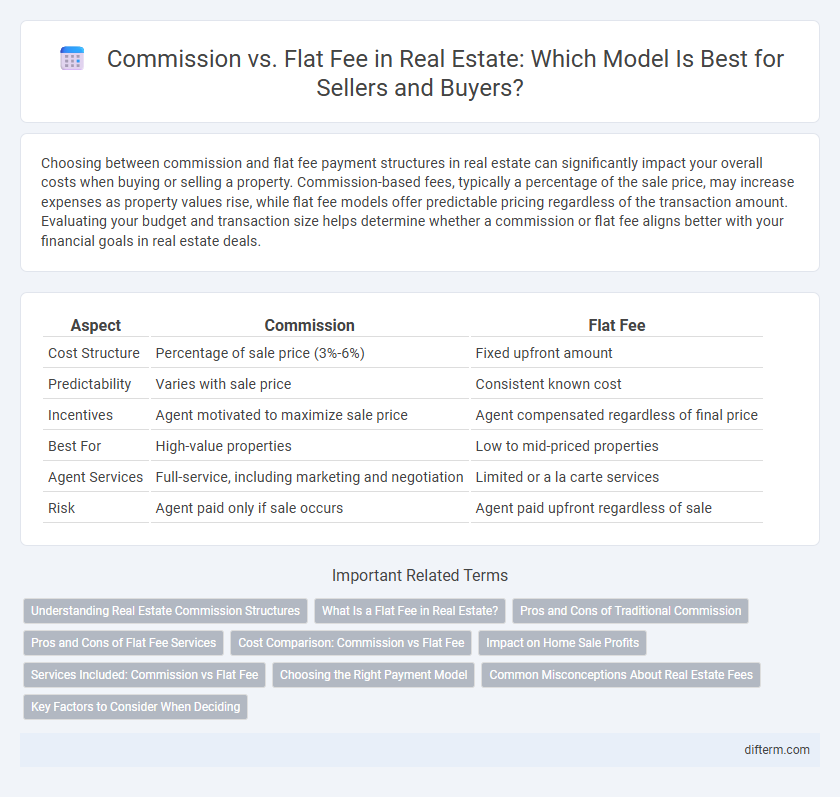Choosing between commission and flat fee payment structures in real estate can significantly impact your overall costs when buying or selling a property. Commission-based fees, typically a percentage of the sale price, may increase expenses as property values rise, while flat fee models offer predictable pricing regardless of the transaction amount. Evaluating your budget and transaction size helps determine whether a commission or flat fee aligns better with your financial goals in real estate deals.
Table of Comparison
| Aspect | Commission | Flat Fee |
|---|---|---|
| Cost Structure | Percentage of sale price (3%-6%) | Fixed upfront amount |
| Predictability | Varies with sale price | Consistent known cost |
| Incentives | Agent motivated to maximize sale price | Agent compensated regardless of final price |
| Best For | High-value properties | Low to mid-priced properties |
| Agent Services | Full-service, including marketing and negotiation | Limited or a la carte services |
| Risk | Agent paid only if sale occurs | Agent paid upfront regardless of sale |
Understanding Real Estate Commission Structures
Real estate commission structures typically involve either a percentage-based commission or a flat fee arrangement, with the average commission rate in the U.S. ranging from 5% to 6% of the property's sale price. Flat fee services offer a predetermined cost regardless of the sale price, appealing to sellers seeking predictable expenses and potentially lower overall costs. Understanding these options enables sellers to choose a commission model that aligns with their budget, property value, and level of agent involvement desired.
What Is a Flat Fee in Real Estate?
A flat fee in real estate is a fixed, predetermined amount paid to a real estate agent or broker regardless of the property's sale price. This model contrasts with the traditional commission-based system, where agents earn a percentage of the sale price. Flat fee services often cover specific tasks like listing the property on the MLS, providing a cost-effective alternative for sellers seeking to minimize selling expenses.
Pros and Cons of Traditional Commission
Traditional commission structures in real estate typically charge a percentage of the home's sale price, usually around 5-6%, incentivizing agents to secure higher sale prices and providing full-service marketing and negotiation support. However, this model can lead to higher overall costs for sellers and may result in agents prioritizing larger transactions over smaller or quicker sales. While commissions align agent motivation with seller success, the percentage-based fee lacks transparency and can be less cost-effective compared to flat fee alternatives.
Pros and Cons of Flat Fee Services
Flat fee real estate services offer predictable costs, making budgeting easier for sellers while eliminating high commission percentages. Sellers may benefit from retaining more profit compared to traditional commission structures, but these services often require more seller involvement in marketing and negotiations. Limited agent support and potential reduced exposure in multiple listing services are notable trade-offs to consider when opting for flat fee arrangements.
Cost Comparison: Commission vs Flat Fee
Commission-based real estate agents typically charge 5-6% of the home's sale price, resulting in higher costs for expensive properties. Flat fee services offer a fixed rate, often ranging from $500 to $1,500, providing predictable expenses regardless of home value. Choosing a flat fee model can significantly reduce selling costs, especially for high-value real estate transactions.
Impact on Home Sale Profits
Choosing a commission-based real estate agent typically results in higher overall costs due to percentage fees ranging from 5% to 6% of the home sale price, directly reducing net profits for sellers. Flat fee arrangements offer predictable expenses, often between $500 and $2,000, allowing sellers to retain a larger portion of their home sale profits. Evaluating the impact on profit margins requires considering home value, agent services, and local market conditions to determine the most cost-effective payment structure.
Services Included: Commission vs Flat Fee
Commission-based real estate fees typically include comprehensive services such as marketing, negotiation, staging advice, and transaction management, ensuring full support from listing to closing. Flat fee arrangements often provide limited services, focusing mainly on listing the property on multiple listing services (MLS) while requiring sellers to handle negotiations and showings independently. Understanding these service differences helps sellers choose between full-service assistance with commission fees or cost-saving flat fee models with more self-management.
Choosing the Right Payment Model
Selecting the right payment model between commission and flat fee depends on the property's value and the seller's budget flexibility. Commission-based models typically incentivize agents to maximize sale prices, while flat fee options offer predictable costs regardless of sale outcome. Analyzing local market trends and agent performance can help determine the most cost-effective and efficient payment structure for both parties.
Common Misconceptions About Real Estate Fees
Many home sellers mistakenly believe that commission fees are always higher than flat fees, but flat fee services can vary widely depending on the provider and service scope. Another common misconception is that flat fees guarantee significant savings, yet hidden costs or limited service offerings often reduce their overall value. Understanding the detailed breakdown of real estate fees helps buyers and sellers make informed financial decisions tailored to their needs.
Key Factors to Consider When Deciding
Evaluating commission versus flat fee in real estate requires analyzing property value, service scope, and market conditions to determine cost-effectiveness. Commission-based fees align with sales price, incentivizing agents for higher offers, while flat fees provide predictable expenses regardless of final sale amount. Consider agent experience, marketing services, and transaction complexity to choose the optimal payment structure that balances budget and desired support level.
Commission vs Flat Fee Infographic

 difterm.com
difterm.com